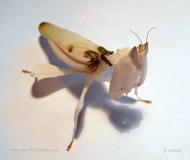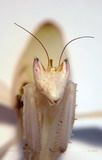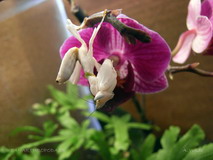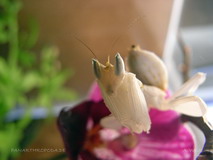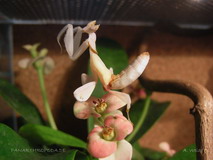- Acanthopidae
- Amorphoscelidae
- Empusidae
- Eremiaphilidae
- Hymenopodidae
- Iridopterygidae
- Liturgusidae
- Mantidae
- Metallyticidae
- Sibyllidae
- Tarachodidae
- Thespidae
- Toxoderidae

Hymenopus coronatus (Olivier, 1792)
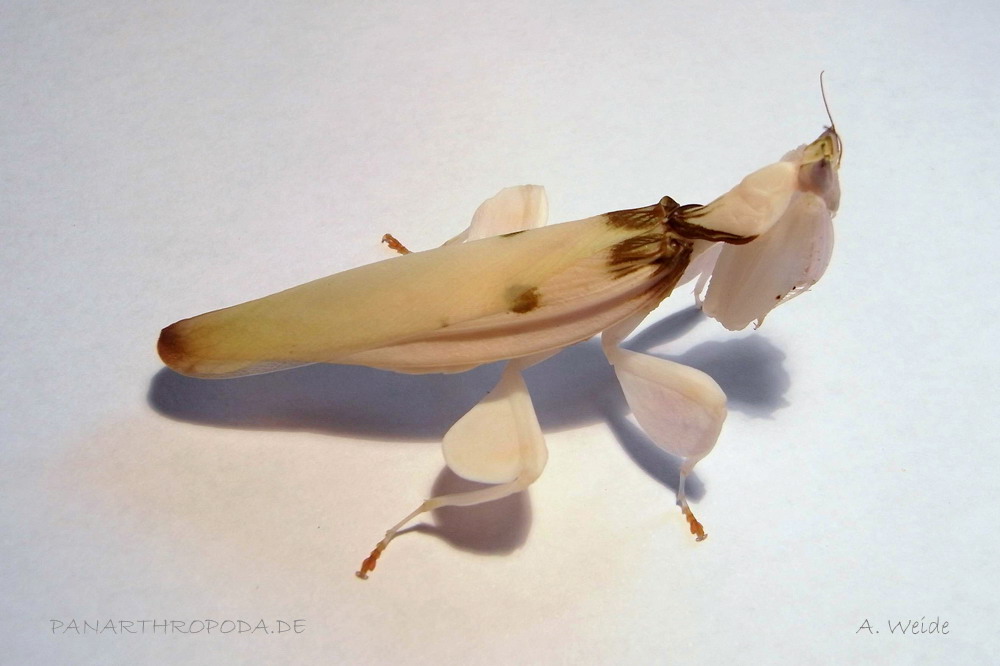
Adult female
Origin and occurrence
The distribution area of Hymenopus coronatus spans starting at North-East India over Thailand and Malaysia to the southasian Islands. There it has been found on Bornea, Java, Sumatra and Ambon. My specimen originated from Java (IGM-Nr. 125).
Appearance and sexual dimorphism
Hymenopus coronatus is a medium sized mantid of the "normal type". The females reach about 5 cm in size, where the wings overhang the abdomen. The animals are of a white base color with brown wingbases and tips. Two round brown-green dots show on the first third of the tegmina (wingcovers). The lower border of the pronotum is colored brown, too. The long, cone shaped eyes, that shimmer pink to violett, and the long vertex are characteristic for this species. 5 light brown stripes run over the abdomen, but do not reach its end. The lobelike appendage on the femora are also noticeable. Combined with the white and pink color they result in a phytomimesis of a flower. This habitus should serve to attract prey and as camouflage.
The males reaching about 2,5 cm are significantly smaller than the females and are much less robust. Meso- and Metathorax including the walking legs and the wingbases are light brown. The rest of the habitus is similar to that of the female.
The sexes of juveniles can be distinguished be counting abdominal segments (8 for males, 6 for females). Older larvae can be sexed by size.
Behavior
Hymenopus coronatus is a rather calm species of mantis. They will often stay at one spot over days without much movement. When disturbed they partially react in a similarely calm manner, but sometimes will flee by running or jumping away.
The preying habits of this species are paticularely interesting. Flying insects will be caught mid-flight without a problem. Groundliving prey will be cunningly stalked with slow and rhythmic movements. The last centimeters will be reached by stretching and bending forwards to catch the prey with the raptorial legs.
The wings are rarely used in the terrarium (that goes for both sexes). The males however, are excellent flyers when there is enough space, so be careful when taking them out of the container. Females can not fly, the wings are at the most used to aid in longer jumps.
The females of Hymenopus coronatus are quite aggressive against others and must therefore be kept seperately. The males are less aggressive and can be kept in groups when properly fed.
Keeping conditions
The space offer should be focused on the space needed for molting, because as mentioned before Hymenopus coronatus is quite inactive. Therefore a container measuring 20x20x30 cm is sufficient for a single female. The males can be kept starting at 10x10x15 cm for one specimen, or starting at 20x20x20 cm for a group of about 5 to 8 specimen. The container should be fitted with twigs, but take into account the space needed for the animals to molt. Humus as substrat is a good choice, it should be kept moist to reach a constant, high humidity. The animals drink frequently and so spraying the inside of the container (walls etc.) regularely is adviced. Temperatures of 25 to maximum 30 °C during day are to be reached, at night the regular 20 °C are fine. When temperatures reach over 30 °C, the animals will encounter problems. Since this species inhabits tropical regions, the day-night-cycle should be about 12 hours long.
Flying insects such as flies, moths, bees and so forth can be used as food, since Hymenopus coronatus can dexterously catch them mid-flight.
Due to the mimesis it is a good idea to introduce flowering plants into the container. One can however not expect them to actually sit on the flowers, since most mantids just seek out the highest place possible (in most cases the ventilation mesh).
Mating and raising the young
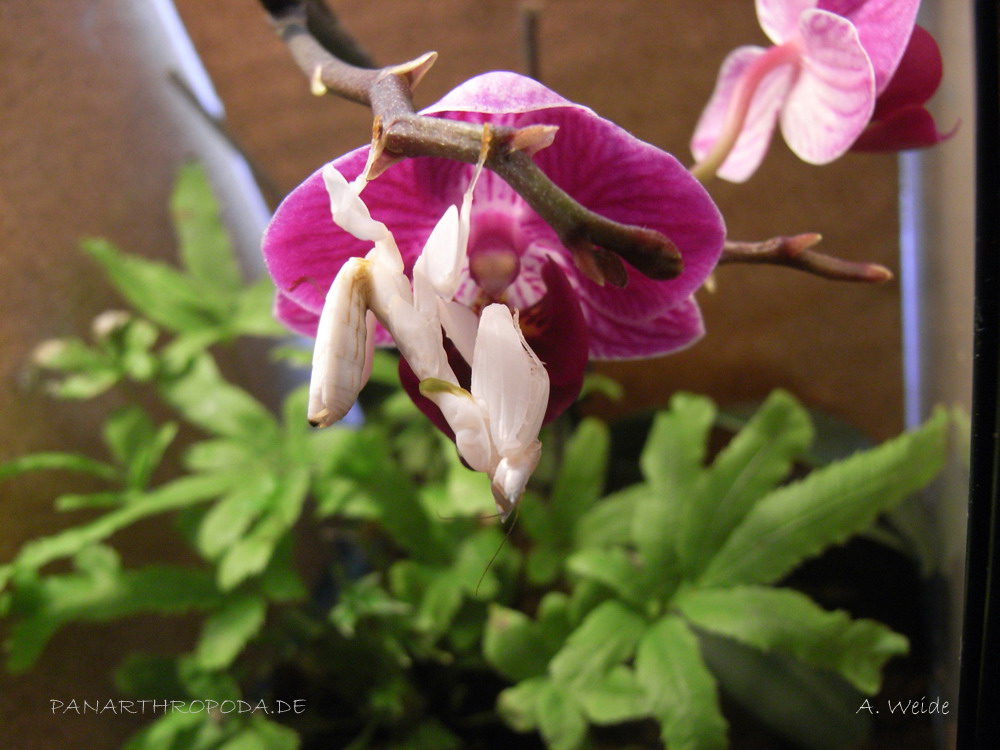
Juvenile female
Raising the larvae is rather easy. When kept as mentioned above, the animals should develope without a problem. Just keep in mind to seperate the females as soon as possible to avoid cannibalism. With some practice sexing can be done starting at the 3rd to 4th larva stadium.
Breeding these animals is a little more difficult. Since the males molt some times less than the females, it can happen that the males drop dead before the females reach adulthood. Therefore one should keep the males much cooler (20 to 22 °C) after a certain age and feed them less often. This reduces their speed of developement. When the females are subadult one can again keep the males regularely to make sure they reach adulthood together with the females. An ideal point in time is with or about one week after the females.
When the females are sexually mature and ready for mating (about 2 to 3 weeks after the last molt), they will start to spray pheromones. To achieve this, they will bend their abdomen downwards and one can observe rhythmical pumping movements. Now is the time to place the male behind or on top of the female (the males are ready for mating about 1 week after the last molt). The male will then start to drum on the female to calm it and raise the mood for mating, using its raptorial legs. Soon after the male will insert its abdomen into the genital opening of the female to pass the spermatophore. After a successful fertilization the female can lay about 2 to 3 oothecae. I have never seen them laying more then 4. The oothecae will be placed on smooth surfaces, almost never on twigs.
The oothecae should be yielded at about 30 °C during day and 20 °C during night. 4 to 6 weeks later about 20 to 30 young will hatch, but I have had oothecae with little more then 50 young. The young should then be fed with Drosophila hydei, but starting at about L3 houseflies can be fed, too.
The larvae are quite variable in color. In L1 the are colored orange with a black head and extremities. This ant minikry is lost one molt further and from there on they are colored in the usual white. They can be completely white or even pink. The pink coloration can mainly be seen on tibiae of the raptorial legs, the femora of the walking legs and the rear part of the abdomen. This pink coloration is lost when they molt into adulthood. The rear part of the pronotum of the young is colored green, will get darker over time and reach a brown in the adults.
Diagnosis
This beautiful and rather easily kept species is good for beginners. It is much more difficult to keep the breeding over several generations. The need for space of the females can be a bit problematic too, since they must be kept seperately.
A. Weide

